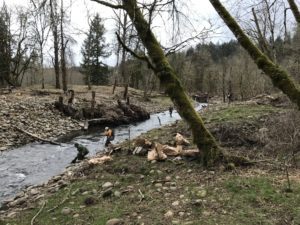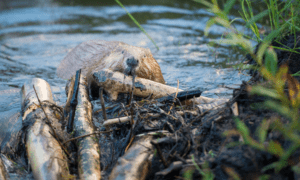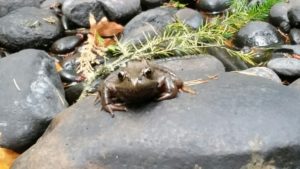Plants & Wildlife in the watershed
Plants of the Clackamas River
 As you recreate and enjoy the Clackamas River, you’ll notice a diverse array of trees, shrubs, plants and grasses lining the waterway. These specialized areas where land and water meet, or riparian zones, are of great value to our fish and wildlife. Not only do these areas provide habitat, food, and shelter for wildlife, riparian zones also provide water filtration, erosion control, and contribute to overall water quality.
As you recreate and enjoy the Clackamas River, you’ll notice a diverse array of trees, shrubs, plants and grasses lining the waterway. These specialized areas where land and water meet, or riparian zones, are of great value to our fish and wildlife. Not only do these areas provide habitat, food, and shelter for wildlife, riparian zones also provide water filtration, erosion control, and contribute to overall water quality.
Along the Lower Clackamas River, some common native trees you will see are Black Cottonwood – North America’s tallest deciduous tree, Big Leaf Maple, Douglas Fir, Western Red Cedar, Pacific Willow, Oregon Ash and Red Osier Dogwood. Native shrubs include Oregon Grape – Oregon’s state plant, Snowberry, Douglas Spirea, Osoberry, and Salmonberry. Other native plants include Common Camas, Licorice Root Fern, Sword Fern, Fringecup, and Western Trillium.
Also lurking along our waterways and wreaking havoc to riverbanks are invasive weeds such as English Ivy, Himalayan Blackberry, Japanese Knotweed, and Old Man’s Beard – or Clamatis Vitalba. These noxious weeds can outcompete native plants and contribute to increased erosion, degraded riparian zones, and impaired water quality.
Several organizations are working to remove these invasive weeds including the Clackamas River Basin Council and the Clackamas Soil and Water Conservation District.
The Importance of Riparian Areas
 The border of moist soils and plants next to a body of water, or riparian area, are only a small part of the natural landscape, but they are of great value to fish and wildlife. Riparian areas may only be a foot wide, like a steep bank of a small creek, or hundreds of feet wide along a lowland stream. Despite their relatively small size, riparian and wetland areas are used at some time by nearly all of the animal species in Oregon and Washington.
The border of moist soils and plants next to a body of water, or riparian area, are only a small part of the natural landscape, but they are of great value to fish and wildlife. Riparian areas may only be a foot wide, like a steep bank of a small creek, or hundreds of feet wide along a lowland stream. Despite their relatively small size, riparian and wetland areas are used at some time by nearly all of the animal species in Oregon and Washington.
Riparian areas help provide most, or all, of the needed elements of good habitat to a wide variety of fish and wildlife species. Food, water, cover from predators, cover from heat and cold, and breeding and rearing areas are wildlife requirements. Native fish require clean, cool water year-round, cover from predators, food, and stable spawning and rearing areas. Trees are a good example of how interconnected and constantly changing riparian areas are. For example, trees shade streams keeping water cool while stabilizing banks and providing food for insects that fish eat. When trees die and fall into streams, the logs create small dams and pools that offer fish rearing habitat and cover from predators.
Red alder, cedar, and salmonberry are some of the well known plant species that commonly grow in the riparian areas of the Clackamas River.
Animals of the Clackamas River
 While on the river, you will likely observe many different types of wildlife. When looking up at the sky, larger bids such as Bald Eagles, Osprey, Turkey Vultures, and Belted Kingfishers can be seen soaring above the river. Other birds commonly found in the tree canopy include Steller’s Jay, Scrub Fay, Spotted Towhee, Junco and Song Sparrow. Keep an eye out in the spring and summer for our migratory birds including Black-headed Grosbeak, Swainson’s Thrush, Goldfinches, Wilson’s Warbler and more.
While on the river, you will likely observe many different types of wildlife. When looking up at the sky, larger bids such as Bald Eagles, Osprey, Turkey Vultures, and Belted Kingfishers can be seen soaring above the river. Other birds commonly found in the tree canopy include Steller’s Jay, Scrub Fay, Spotted Towhee, Junco and Song Sparrow. Keep an eye out in the spring and summer for our migratory birds including Black-headed Grosbeak, Swainson’s Thrush, Goldfinches, Wilson’s Warbler and more.
Click here for a list of resident and migratory birds: https://myodfw.com/wildlife-viewing/species/birds
You may also spot many mammals, amphibians and maybe even a reptile. Mammals include beavers, river otters, squirrels, coyotes, and black-tailed deer. Amphibians include Rough-skinned Newts, Dunn’s Salamander, and Pacific Treefrog.
Sensitive Wildlife
 The Clackamas is also home to many sensitive species of wildlife that are of conservation concern to the Oregon Department of Fish and Wildlife. Amphibians such as the Cascade torrent salamander, red-legged frog and the foothill yellow-legged frog are listed as sensitive. Oregon’s only two native turtle species are listed as sensitive; the Northwestern Pond Turtle and the Western Painted Turtle. In addition, three myotis bat species, several bird species such as the Willow Flycatcher,
The Clackamas is also home to many sensitive species of wildlife that are of conservation concern to the Oregon Department of Fish and Wildlife. Amphibians such as the Cascade torrent salamander, red-legged frog and the foothill yellow-legged frog are listed as sensitive. Oregon’s only two native turtle species are listed as sensitive; the Northwestern Pond Turtle and the Western Painted Turtle. In addition, three myotis bat species, several bird species such as the Willow Flycatcher,
Feeding the ducks is a common pass-time in the Lower Clackamas River. At Clackamette Park, a common sight is dozens of ducks and geese crowding together waiting for someone to drop a loaf of bread. But that is not great for ducks! Here’s why:
- Human food harms ducks and geese: Feeding our waterfowl leads to starvation, deformation of wings, increased disease, and shortened life expectancy.
- Feeding causes impaired water quality: Feeding our ducks and geese leads them to overcrowd the feeding areas, causing impaired water quality due to algal blooms and increased bacteria.
- It negatively impacts bird behavior: When we feed ducks, it suppresses the instinct to migrate and causes them to lose their healthy fear of humans.
- Feeding ducks degrades habitats: Overcrowding leads to trampled and contaminated riverbanks.
In the wild, ducks and geese feed on numerous types of grasses, invertebrates, and aquatic plants. These healthy foods provide all the nutrients and protein that ducks and geese need to live long, healthy lives. It might be fun, but people food such as bread, crackers, or chips causes wild animals to feel full while depriving them of the nutrients and protein they require to live long, healthy lives.
